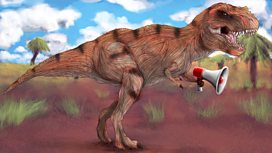Mammoths
Brett Westwood explores the role woolly mammoths have played in our lives since the ice age. Our ancestors used them for food and instruments, today they are in Hollywood films.
"Manny" the hairy, grumpy, yet ultimately caring hero of the animation series Ice Age sums up our love of these giants of the past. When a superbly preserved baby mammoth was displayed at the Natural History Museum she became a star attraction.
We are intrigued by the idea of a hairy elephant wandering our land so tantalisingly recently; the last mammoths are thought to have died out in Russia just 4,000 years ago. Bones of these huge elephants have often been found, people believing they were the remains of giants, or that they were the huge burrowing creatures that died underground.
Beautiful paintings of mammoths adorn ice age cave walls, symbolising our close relationships with these animals that provided us with so much cultural material. Not only mammoth meat but bones and tusks to build shelter, skins for walls, ivory for carvings and teeth for musical instruments; the first flute was a mammoth bone.
Music played on instruments made from mammoth bone created haunting sounds. Delicately carved tiny mammoths are found in places many miles from where mammoths lived, dating back at least 30,000 years. If they were alive today we would no doubt be protecting them from ivory traders, but as they are extinct, the mass of ivory bone being exhumed from the tundra (it is thought there are 150 million tusks buried there) is legally sent to China to be made into jewellery, trinkets and pieces of art.
Not far off 50% of the ivory entering China is mammoth. Some think it is a sustainable alternative to elephant ivory, others believe it keeps the whole trade alive. Should mammoth ivory be treated the same as elephant? Should mammoth become the first extinct animal to be listed as an endangered species?
Last on
![]()
From flutes to fossils - read our facts about mighty mammoths.
![]()
The World According to Mammoth
A Natural Histories Comedy featuring Harriet Carmichael.
![]()
Dinosaurs
Brett Westwood explores how dinosaurs are influencing our stories, films and science.
Clips
-
![]()
The World According to Mammoth
Duration: 01:37
-
![]()
The growing and legal trade in mammoth ivory
Duration: 05:36
-
![]()
Did humans hunt woolly mammoths?
Duration: 01:03
Professor Adrian Lister

He is the author of more than 150 scientific papers and four books, Evolution on Planet Earth, Mammoths: Giants of the Ice Age, Mammoths: Ice Age Giants and a children’s book, Tracker’s Guide to Ice Age Animals. Prior to joining the Museum, he was Professor of Palaeontology at UCL. He completed his PhD at Cambridge on evolution of fossil mammals.
Jill Cook

As well as collaborations with several UK museums she has curated successful exhibitions at the British Museum. These include Made in Africa and The Swimming Reindeer both of which linked with the major ����ý – British Museum project . In 2013 she curated two ground breaking exhibitions: at the British Museum and El arte en la epoca Altamira at the Fundacion Botin in Santander and wrote the accompanying books in which her fascination for natural history came to the fore.
Anna Friederike Potengowski

As a contemporary musician, she has performed with various ensembles, including the . She has also played at the and the in Dresden.
Picture: Frank Korte Photography
Adrienne Mayor

Her two books on pre-Darwinian fossil traditions in classical antiquity and in Native America; �����Ի��� have opened up a new field within geomythology.
�շɾ��ٳٱ��:��
Lucy Vigne and Dr Esmond Martin

Dr Esmond Martin has investigated the trade in rhino products and co-authored monographs on the world's invory markets. Recently, he and Lucy Vigne produced a report entitled .
Jay Wilson
He lives in Malibu, California with Regina Wilson, who is a film editor and scriptwriter.
Broadcasts
- Tue 11 Aug 2015 11:00����ý Radio 4 FM
- Mon 17 Aug 2015 21:00����ý Radio 4








